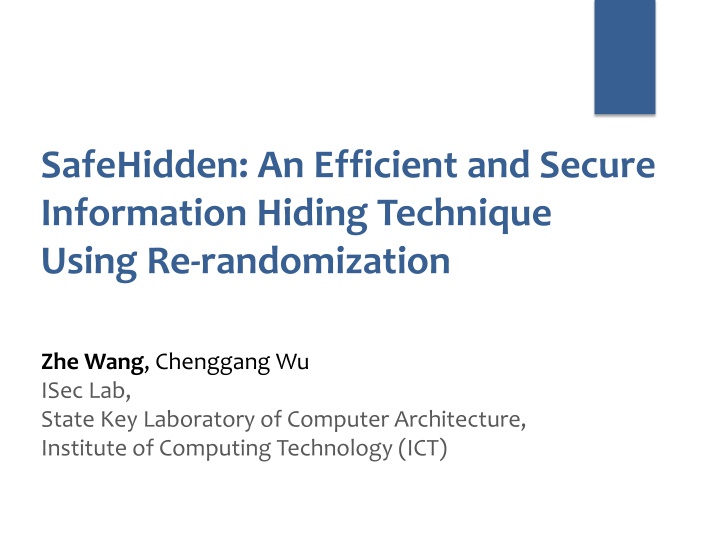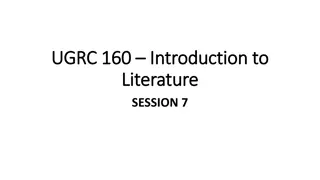Teaching Grammar & Poetry Part 2
In this session, we delve into word classes by analyzing a poetic paragraph. Explore how to integrate literature in language teaching. Get insights on planning effective English lessons for different stages of education. Enhance your teaching skills with practical sequences.
Uploaded on Mar 01, 2025 | 0 Views
Download Presentation

Please find below an Image/Link to download the presentation.
The content on the website is provided AS IS for your information and personal use only. It may not be sold, licensed, or shared on other websites without obtaining consent from the author.If you encounter any issues during the download, it is possible that the publisher has removed the file from their server.
You are allowed to download the files provided on this website for personal or commercial use, subject to the condition that they are used lawfully. All files are the property of their respective owners.
The content on the website is provided AS IS for your information and personal use only. It may not be sold, licensed, or shared on other websites without obtaining consent from the author.
E N D
Presentation Transcript
SafeHidden: An Efficient and Secure Information Hiding Technique Using Re-randomization Zhe Wang, Chenggang Wu ISec Lab, State Key Laboratory of Computer Architecture, Institute of Computing Technology (ICT)
Information Hiding Technique Information Hiding Technique Hiding an important area at a random location Has no pointers in memory referring to it Is as small as possible Normal accesses are done through an offset from a dedicated register [stack] [heap] executables libraries It is widely used in Code Pointer Integrity Control Flow Integrity Code (Re-)Randomization Hidden Address Space
Information Hiding is Not Secure Any More Recent attacks have made it vulnerable again. Via breaking the assumptions of this technique !!! Rethink the assumptions of IH : 1. Failed guesses could crash the program Avoid crash 2. Safe area is designed very small (high entropy) Reduce entropy 3. Normal accesses will not leak the location Leak page table structure
Attacks against Information Hiding %gs:0x0 0x1fafe7fbf000 0 128T Safe Area Bingo Virtual Address library main stack Crash Crash Avoid Crash CROP attack [NDSS 16] Using the exception handling mechanism to avoid crash. Clone-probing attack [S&P 14] Probing the child processes to avoid crash the parent process.
Attacks against Information Hiding %gs:0x0 0x1fafe7fbf000 0 128T Safe Area Safe Area Safe Area Safe Area Safe Area Safe Area Virtual Address library main stack Bingo Reduce Entropy Attack via spraying safe areas [SECURITY 16] Spraying thread-local safe areas via spraying threads.
Attacks against Information Hiding %gs:0x0 0x1fafe7fbf000 0 128T Safe Area Bingo Virtual Address library main stack Reduce Entropy Attack via spraying safe areas [SECURITY 16] Spraying thread-local safe areas via spraying threads. Attack via filling memory holes [SECURITY 16] Allocating memory to occupy the unmapped areas.
Attacks against Information Hiding Attack against Page Table Structure[NDSS 17] 128T 0 Safe Area Virtual Address library main stack %gs:0x0 = 0x??????????? 0x1fafe7fbf000 = PRIME+PROBE Leak Page Table 0 4G Physical Address Image fromhttps://www.vusec.net/projects/xlate/
Outline Threat Model Attack vectors Our design System Implementation Evaluation
Threat Model We consider an IH-based defense that protects a vulnerable application against code reuse attacks. Web servers or browsers. The design of this IH-based defense is not flawed: Before launching code reuse attacks, attackers must circumvent the defense by revealing the safe area. Attackers abilities Read and write arbitrary memory locations; Allocate and free arbitrary memory areas; Create any number of threads;
Outline Threat Model Attack vectors Our design System Implementation Evaluation
Attack Vectors Summary of Attacks Vector-1 Gathering memory layout information to help to locate safe areas Vector-2 Creating opportunities to probe safe areas without crashing the system Vector-3 Reducing the entropy of the randomized safe area locations Vector-4 Monitoring page-table access patterns using cache side channels
Outline Threat Model Attack vectors Our design System Implementation Evaluation
Our Design SafeHidden SafeHidden is proposed to block these attack vectors Mediating all types of probes that may leak the locations Randomizing safe areas upon detecting suspicious probes Isolating the thread-local safe areas Raising security alarms when illegal probes are detected
Block Attack Vector-1 Vector-1 Gathering memory layout information to help to locate safe areas [stack] [heap] executables libraries Hidden But persistent attacks could always succeed. Address Space
Block Attack Vector-2 Vector-2 Creating opportunities to probe safe areas without crashing the system [stack] [stack] [heap] [heap] Leave Traps executables executables libraries libraries Hidden Hidden But persistent attacks could always succeed. Address Space Address Space
But when to perform randomization? Events Interception Points memory management system calls mmap, munmap, mremap, mprotect, brk [stack] Hidden syscalls that could return EFAULT read, write, access, send, ... cloning memory space clone, fork, vfork memory access instructions page fault exception [heap] Unmapped Area (UA) Safe Area (SA) Trap Area (TA) Other Area (OA) executables libraries Responses in SafeHidden Events SA UA TA OA Hidden memory management system calls Alarm Rand Alarm syscalls that could return EFAULT Alarm Rand Alarm cloning memory space Rand Rand Rand Rand memory access instructions Rand Alarm Address Space
Block Attack Vector-3 Vector-3 Reducing the entropy of the randomized safe area locations SafeHidden prevents unlimited shrink of unmapped areas and unrestricted growth of safe areas. The maximum size of the mapped area is set to 64 TB. It is half of the entire virtual address space in the user space. Using thread-private memory mechanism to isolatethread- local safe areas. The entropy will not be reduced by thread spraying.
Thread-private Memory Instead of using the thread-private page table method, we use a thread-private EPT method to avoid the compatible problem. Thread0 Virtual Memory Thread1 Virtual Memory Guest Page Table CR3 CR3 EPTP EPTP Core 1 Core 0 Guest Guest Physical Memory Host EPT0 EPT1 Host Physical Memory
Thread-private Memory Instead of using the thread-private page table method, we use a thread-private EPT method to avoid the compatible problem. Thread0 Virtual Memory Thread1 Virtual Memory P 2 P 3 P 0 P 1 Guest Page Table P 0 Thread0 s safe area P 2 P 3 P 1 Thread1 s safe area CR3 CR3 P 5 EPTP EPTP Core 1 Core 0 Guest Guest Physical Memory Host EPT0 EPT1 P 6 Host Physical Memory
Block Attack Vector-4 Vector-4 Monitoring page-table access patterns using cache side channels Observation It needs hundreds of Prime+Probe or Evict+Time tests. It is also imperative that the test address remains the same and the PTEs remain the same, too. Solution: Re-randomization!
Block Attack Vector-4 SafeHidden also monitors legal accesses to the safe area that may be triggered by the attacker on purpose. Once such a legal access is detected, SafeHidden will randomize the location of the safe area. The virtual address of the safe area is changed. The corresponding PTEs and their cache entries no longer reflect the real virtual address of the safe area. But, how to detect this legal access from the attacker?
Block Attack Vector-4 The key step of cache side-channel attack against page table is to force a page table walk. We could intercept TLB misses !!! But, how to only intercept the TLB miss occurred in safe areas?
Convert TLB Miss to Page Fault Exception When the reserved bit is set, a page fault exception will be triggered during the page table walk. SafeHidden sets the reserved bit in all of the PTEs for the safe areas to detect the TLB misses. When a TLB miss occurs, it is trapped into the pf handler.
Flowchart of Page Fault Handler Return from Trap Retry will hit in TLB Virtual Address Relocate to the New Address 6 TLB Lookup Set Reserved Bit in All of PTEs 5 Two Problems Original Page Fault Handler TLB Hit? Y How to insert TLB entry under KPTI 4 Insert TLB Entry N Y Possible RSVD ==0? Hardware Page Table Walk Cause false alarm TLB misses at new location Trap 3 Randomization N 2 Trap Handler: Instrumented #PF Clean All Page Table Entries 1 Physical Address
Outline Threat Model Attack vectors Our design System Implementation Evaluation
Architecture Overview SafeHidden is designed as a loadable kernel module. No need to modify the existing defenses. No need to re-compile the OS kernel. We integrated a thin hypervisor into the kernel module for a non-virtualized OS. The thin hypervisor virtualizes the running OS as the guest without rebooting the system. The other components, called GuestKM, runs in guest kernel.
Architecture Overview Protected APP s thread0 Protected APP s thread1 Other Applications SafeHidden OS Kernel Page Tables Kernel Module Function Module #511 . . . . . . Process Sched Syscall Interceptor #0 Checker Linux Notifier Randomizer Sync EPT Switch EPT #PF Interceptor vmcall Inject Interrupt Hypercall Handlers EPT Intercept Events Violation Handler #511 . . . . . . #0 Hardware Hypervisor Extended page tables
How to Integrate SafeHidden with KPTI? KPTI splits the page table for each process into a user-mode page table and a kernel-mode page table. PCID is used to avoid the TLB flush during context-switch. Kernel Mode User Mode TLB PC PCID VPN->PFN SafeHidden CR3[11] = 1 kPCID 0xsafehidden->0x Kernel Space Kernel Space kPCID kPCID 0xsafehidden->0x Safe Area Safe Area kPCID 0xsafehidden->0x User Space User Space uPCID CR3[12] = 0 PGD Kernel PGD User physical memory
How to Integrate SafeHidden with KPTI? The TLB entry loaded in kernel-mode page table with kPCID cannot be used by user-mode code! Kernel Mode User Mode TLB PCID VPN->PFN SafeHidden CR3[11] = 1 kPCID 0xsafehidden->0x Kernel Space Kernel Space kPCID kPCID 0xsafehidden->0x PC Safe Area Safe Area kPCID 0xsafehidden->0x TLB miss User Space User Space kPCID 0xsafearea ->0x uPCID CR3[12] = 0 PGD Kernel PGD User physical memory
How to Integrate SafeHidden with KPTI? SafeHidden proposed to bind kernel-mode page table with uPCID temporarily. Kernel Mode User Mode TLB PC PCID VPN->PFN SafeHidden CR3[11] = 1 kPCID 0xsafehidden->0x Kernel Space Kernel Space kPCID kPCID 0xsafehidden->0x Safe Area Safe Area kPCID 0xsafehidden->0x User Space User Space uPCID CR3[12] = 0 PGD Kernel PGD User physical memory
How to Integrate SafeHidden with KPTI? SafeHidden proposed to bind kernel-mode page table with uPCID temporarily. But some pages related to this operation are also loaded. Kernel Mode User Mode TLB PC PCID VPN->PFN SafeHidden CR3[11] = 1 kPCID 0xsafehidden->0x Kernel Space Kernel Space kPCID kPCID 0xsafehidden->0x PC Safe Area Safe Area kPCID 0xsafehidden->0x TLB hit User Space User Space uPCID 0xsafearea ->0x uPCID CR3[12] = 0 PGD Kernel PGD User physical memory
How to Integrate SafeHidden with KPTI? SafeHidden proposed to bind kernel-mode page table with uPCID temporarily. But some pages related to this operation are also loaded. Kernel Mode User Mode TLB PC PCID VPN->PFN SafeHidden CR3[11] = 1 kPCID 0xsafehidden->0x Kernel Space Kernel Space kPCID kPCID 0xsafehidden->0x Safe Area Safe Area kPCID 0xsafehidden->0x User Space User Space uPCID 0xsafearea ->0x uPCID uPCID 0xsafehidden->0x CR3[12] = 0 PGD Kernel PGD User physical memory To avoid these TLB entries to be exploited by the Meltdown attack, we flush them by using invcpid instructions
Reloading TLB Entries after Randomization SafeHidden uses the Intel TSX to test which PTEs of safe areas are loaded in the TLB. And then loading them into TLB after randomization to avoid many false alarms of TLB misses. if_xbegin()== _XBEGIN_STARTED: access a page in safe area _xend() else fallback routine When MMU walk a poisoned PTE, it will trigger #PF, and then captured by Intel TSX. Abort if it is not in TLB
Outline Threat Model Attack vectors Our design System Implementation Evaluation
Performance Evaluation CPU-intensive benchmarks SPEC CPU2006 benchmark with ref input Incurred 2.75% and 2.76% when protecting O-CFI and Shadow Stack. Multi-threaded Parsec-2.1 benchmark with native input Incurred 5.78% and 6.44% when protecting O-CFI and Shadow Stack.
Performance Evaluation Network I/O benchmarks Apache is configured to work mpm-worker mode (8 threads). Incurred 12.07% and 12.18% when protecting O-CFI and Shadow Stack. Nginx is configured to work with 4 worker processes. Incurred 5.35% and 5.51% when protecting O-CFI and Shadow Stack.
Performance Evaluation Disk I/O benchmarks Bonnie++ benchmark tool (read and write tests) Incurred 1.76% and 2.18% when protecting O-CFI and Shadow Stack.
Conclusion SafeHidden proposes the re-randomization based IH technique against all known attacks. SafeHidden introduces the use of thread-private memory to isolate thread-local safe areas. Using hardware-assisted extended page tables. It devises a new technique to detect TLB misses. It is the key trait of cache side-channel attacks against the location of the safe areas.























